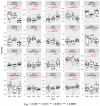Robust Regression Analysis of GCMS Data Reveals Differential Rewiring of Metabolic Networks in Hepatitis B and C Patients
- PMID: 28991180
- PMCID: PMC5746731
- DOI: 10.3390/metabo7040051
Robust Regression Analysis of GCMS Data Reveals Differential Rewiring of Metabolic Networks in Hepatitis B and C Patients
Abstract
About one in 15 of the world's population is chronically infected with either hepatitis virus B (HBV) or C (HCV), with enormous public health consequences. The metabolic alterations caused by these infections have never been directly compared and contrasted. We investigated groups of HBV-positive, HCV-positive, and uninfected healthy controls using gas chromatography-mass spectrometry analyses of their plasma and urine. A robust regression analysis of the metabolite data was conducted to reveal correlations between metabolite pairs. Ten metabolite correlations appeared for HBV plasma and urine, with 18 for HCV plasma and urine, none of which were present in the controls. Metabolic perturbation networks were constructed, which permitted a differential view of the HBV- and HCV-infected liver. HBV hepatitis was consistent with enhanced glucose uptake, glycolysis, and pentose phosphate pathway metabolism, the latter using xylitol and producing threonic acid, which may also be imported by glucose transporters. HCV hepatitis was consistent with impaired glucose uptake, glycolysis, and pentose phosphate pathway metabolism, with the tricarboxylic acid pathway fueled by branched-chain amino acids feeding gluconeogenesis and the hepatocellular loss of glucose, which most probably contributed to hyperglycemia. It is concluded that robust regression analyses can uncover metabolic rewiring in disease states.
Keywords: TCA cycle; gluconeogenesis; glucose transporters; glycolysis; hepatitis B virus; hepatitis C virus; metabolic perturbation networks; metabolomics; pentose phosphate pathway; robust regression analysis.
Conflict of interest statement
The authors declare no conflicts of interest.
Figures






Similar articles
-
Metabolomics in viral hepatitis: advances and review.Front Cell Infect Microbiol. 2023 May 17;13:1189417. doi: 10.3389/fcimb.2023.1189417. eCollection 2023. Front Cell Infect Microbiol. 2023. PMID: 37265499 Free PMC article. Review.
-
Impact of hepatitis B virus infection on hepatic metabolic signaling pathway.World J Gastroenterol. 2016 Sep 28;22(36):8161-7. doi: 10.3748/wjg.v22.i36.8161. World J Gastroenterol. 2016. PMID: 27688657 Free PMC article. Review.
-
Coinfection of Schistosoma Species with Hepatitis B or Hepatitis C Viruses.Adv Parasitol. 2016;91:111-231. doi: 10.1016/bs.apar.2015.12.003. Epub 2016 Feb 5. Adv Parasitol. 2016. PMID: 27015949 Review.
-
Accelerated Metabolite Levels of Aerobic Glycolysis and the Pentose Phosphate Pathway Are Required for Efficient Replication of Infectious Spleen and Kidney Necrosis Virus in Chinese Perch Brain Cells.Biomolecules. 2019 Sep 2;9(9):440. doi: 10.3390/biom9090440. Biomolecules. 2019. PMID: 31480692 Free PMC article.
-
Metabolomics reveals that aldose reductase activity due to AKR1B10 is upregulated in hepatitis C virus infection.J Viral Hepat. 2015 Jul;22(7):617-24. doi: 10.1111/jvh.12376. Epub 2014 Dec 9. J Viral Hepat. 2015. PMID: 25487531
Cited by
-
Metabolic Hijacking of Hexose Metabolism to Ascorbate Synthesis Is the Unifying Biochemical Basis of Murine Liver Fibrosis.Cells. 2023 Feb 2;12(3):485. doi: 10.3390/cells12030485. Cells. 2023. PMID: 36766828 Free PMC article.
-
Metabolomic Hallmarks of Obesity and Metabolic Dysfunction-Associated Steatotic Liver Disease.Int J Mol Sci. 2024 Nov 28;25(23):12809. doi: 10.3390/ijms252312809. Int J Mol Sci. 2024. PMID: 39684520 Free PMC article. Review.
-
Quantitative Bioreactor Monitoring of Intracellular Bacterial Metabolites in Clostridium autoethanogenum Using Liquid Chromatography-Isotope Dilution Mass Spectrometry.ACS Omega. 2021 May 20;6(21):13518-13526. doi: 10.1021/acsomega.0c05588. eCollection 2021 Jun 1. ACS Omega. 2021. PMID: 34095647 Free PMC article.
-
Metabolic Rewiring and the Characterization of Oncometabolites.Cancers (Basel). 2021 Jun 10;13(12):2900. doi: 10.3390/cancers13122900. Cancers (Basel). 2021. PMID: 34200553 Free PMC article. Review.
-
Metabolomics in viral hepatitis: advances and review.Front Cell Infect Microbiol. 2023 May 17;13:1189417. doi: 10.3389/fcimb.2023.1189417. eCollection 2023. Front Cell Infect Microbiol. 2023. PMID: 37265499 Free PMC article. Review.
References
-
- Chang M., Cheng M., Chang S., Tang H., Chiu C., Yeh C., Shiao M. Recovery of pan-genotypic and genotype-specific amino acid alterations in chronic hepatitis C after viral clearance: transition at the crossroad of metabolism and immunity. Amino acids. 2017;49:291–302. doi: 10.1007/s00726-016-2360-7. - DOI - PubMed
-
- Elsemman I.E., Mardinoglu A., Shoaie S., Soliman T.H., Nielsen J. Systems biology analysis of hepatitis C virus infection reveals the role of copy number increases in regions of chromosome 1q in hepatocellular carcinoma metabolism. Mol. Biosyst. 2016;12:1496–1506. doi: 10.1039/C5MB00827A. - DOI - PubMed
LinkOut - more resources
Full Text Sources
Other Literature Sources

